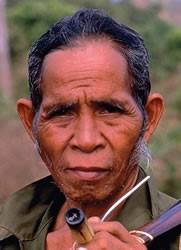Brao in Cambodia

Photo Source:
Copyrighted © 2026
Cambodia Research Network All rights reserved. Used with permission |
Send Joshua Project a map of this people group.
|
| People Name: | Brao |
| Country: | Cambodia |
| 10/40 Window: | Yes |
| Population: | 12,000 |
| World Population: | 41,500 |
| Primary Language: | Brao |
| Primary Religion: | Ethnic Religions |
| Christian Adherents: | 10.00 % |
| Evangelicals: | 8.00 % |
| Scripture: | Portions |
| Ministry Resources: | Yes |
| Jesus Film: | No |
| Audio Recordings: | Yes |
| People Cluster: | Mon-Khmer |
| Affinity Bloc: | Southeast Asian Peoples |
| Progress Level: |
|
Introduction / History
The Brao of northeast Cambodia have dark skin and black hair, resembling the majority Khmer and Lao lowlanders of the region, although Brao are generally shorter in stature. They are one of several hilltribes inhabiting isolated villages in Ratanakiri province of northeastern Cambodia and in Attapeu province of southeastern Laos.
The Brao language is a member of the Mon-Khmer language family. Krung, Kravet, Lun and Laveh are also names for the overall Brao ethnic group. These represent mutually intelligible dialects within the group. Older Brao often wear traditional dress. Their earlobes are stretched from wearing large elephant tusk earrings in the past. Their faces sometimes bear tattoos, also a fashion from the past. Younger people generally wear western clothing purchased in the market.
What Are Their Lives Like?
The Brao differ from the lowland paddy rice farmers of the region. They traditionally depend heavily on the forest for their livelihood and usually grow upland dry rice using swidden agriculture methods. Cash crops like cashew and coffee provide limited income. Rolling forested hills of red volcanic earth cover much of the Brao homeland and several major rivers traverse flat floodplains. Hunting, fishing and raising animals provide protein in their diet. Unfortunately, recent logging has deforested vast tracts of their land. Women are often seen walking the red dirt roads with baskets on their backs carrying produce and goods.
What Are Their Beliefs?
For centuries they have maintained animistic beliefs rather than embracing the Buddhist religion of the lowland people. The Brao live in continual fear of evil spirits. Village elders are responsible for leading village sacrifices made to spirits in the forest, streams, rocks and fields. This maintains order in the community so that the spirits are not disturbed. Village diviners determine the cause of sickness through ritual and prescribe an animal to be sacrificed to the respective spirit.
Sickness and crop failure are generally blamed on spirits. Arak and Bras are the local names for spirits requiring appeasement. Villagers raise chickens, pigs, cows and water buffalo primarily for sacrifice. Village sacrifices, weddings and funerals involve the entire village drinking large quantities of rice wine over several days.
What Are Their Needs?
The Brao were untouched by the gospel until 1992. Today there are around 200 believers in Cambodia in small, isolated groups. However, because of government restrictions, the Brao living in Laos have not yet heard the gospel. A part-time Bible school has begun, and church leader training remains a long-term need.
The Brao are very poor, with little access to schooling, literacy programs and electricity. Additionally, illegal logging and land concessions encroach on traditional Brao land. Access to justice through the court system is difficult to obtain.
Prayer Points
Pray for the Lord to provide for the Brao's material needs as a testimony of his power and goodness.
Pray for Bra disciples who will make more disciples.
Pray for them to find the spiritual hunger it takes to embrace the only savior.